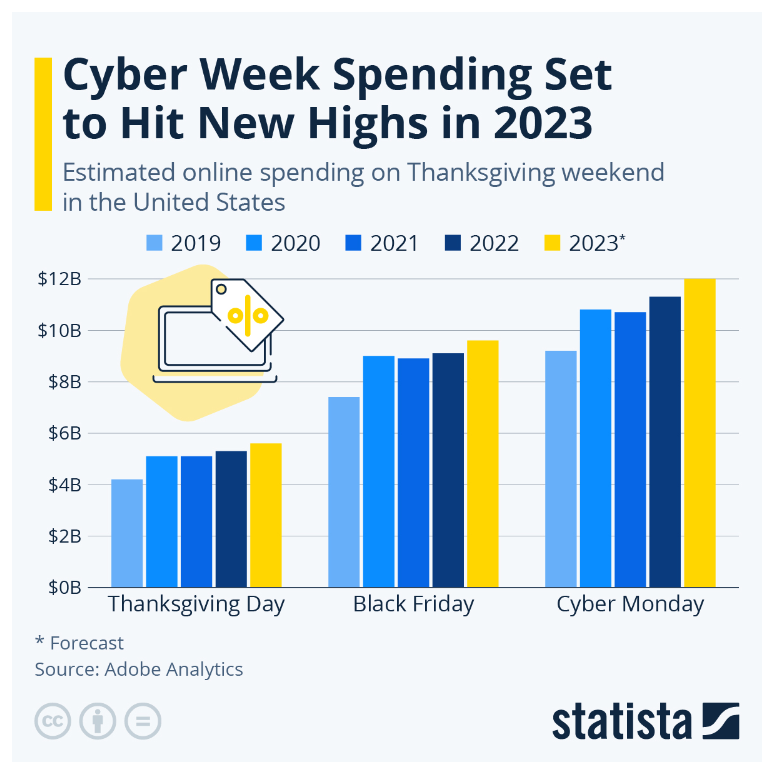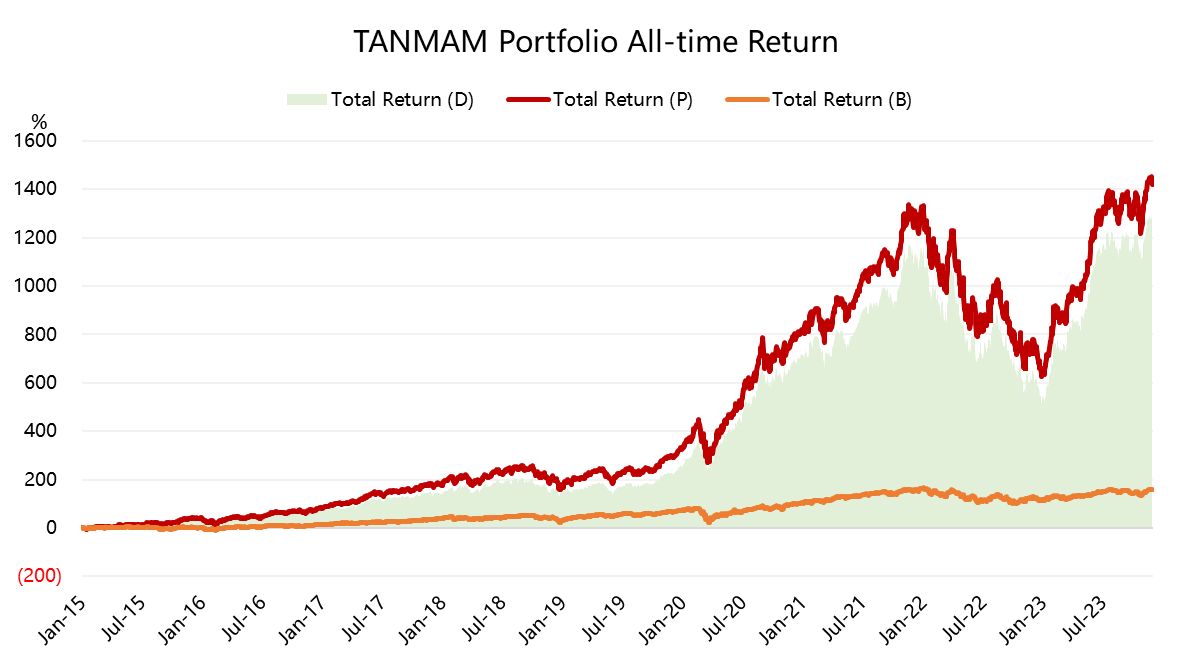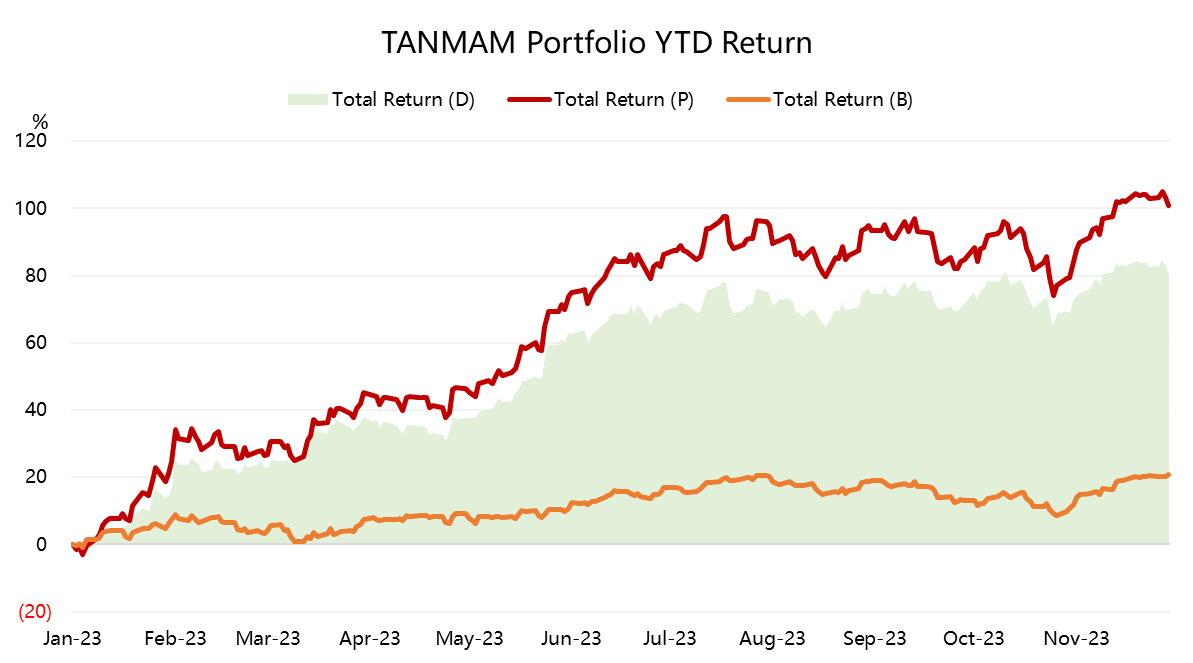Big-Tech’s Performance
November last week, bond yield continued to decline, pushing the stock market further high, but the need for consolidation or downturn is inevitable.
On the trading day of November 30th, $NASDAQ(.IXIC)$ experienced a correction, while the $DJIA(.DJI)$ surged, showing clear divergence.
Big-techs’ performance in the past week (until Nov 30th): $Tesla Motors(TSLA)$ (+2.51%), which had the largest decline the previous week, followed by $Microsoft(MSFT)$ (+0.28%); all the rest declined, including $Amazon.com(AMZN)$ (-0.42%); $Apple(AAPL)$ (-0.71%); $NVIDIA Corp(NVDA)$ (-3.99%); $Meta Platforms, Inc.(META)$ (-4.2%); $Alphabet(GOOG)$ $Alphabet(GOOGL)$ (-4.3%)
Overall, they gave back all the gains from the previous week.
Big-Tech’s Top Newsfeed
- Apple's Vision Pro is about to enter mass production, with the proportion of its mainland China supply chain significantly increased to 60%. The first batch of inventory is around 400,000 units, and the sales target for 2024 is 1 million units, reaching 10 million units in the third year.
- Microsoft will invest $3.2 billion to expand its AI infrastructure in the UK, but Google is calling for UK regulators to take action against Microsoft's cloud services.
- Sam has officially returned to OpenAI as CEO, and the board will accept Microsoft as a non-voting observer and improve governance with diverse perspectives.
- Amazon has released an AI chat tool for enterprise customers, launching the AI assistant Amazon Q.
- Amazon has released an upgraded version of its AI system processor Trainium2, and AWS has expanded its partnership with Nvidia.
- According to third-party data, "Black Friday" and "Cyber Monday" shopping events reached record highs.
- The EU has issued antitrust warnings regarding Amazon's acquisition of $iRobot(IRBT)$
- Jensen Huang stated that AI may surpass human intelligence within 5 years and is developing compliant chips for the Chinese market.
- Tesla has released the Cybertruck, with a starting price of $61,000 and a discounted starting price of $49,000, with a range of 250-340 miles.
Big-Tech’s Key insights
Black Friday sales soared, Amazon outshines its competitors
Amazon has performed exceptionally well in the past two weeks among major tech companies and is also the best-performing company since the release of its financial report.
While most attention has been focused on the presumed "chip" (NVDA) and "AI" (MSFT) that exceeded expectations, AMZN has surprised the market with its performance in both retail and cloud services, successfully "stealing the show" during the Q3 earnings season.
Looking at the sales data from Black Friday, although new platforms like Temu $Pinduoduo Inc.(PDD)$ and Shein have joined the competition, and many analysts previously believed that high prices would hinder consumer spending, sales still reached new highs. This is consistent with Amazon's Q3 financial report, which also exceeded expectations in its e-commerce business.
Some highlights
1. Inflation has indeed put pressure on consumer spending. Mastercard data shows that Black Friday retail sales increased by 2.8% YoY, with online transactions growing by 8.5% and in-store transactions only growing by 1.1%. Therefore, physical stores are under more pressure, and the consumer spending of retailers like $Wal-Mart(WMT)$ and $Target(TGT)$ (excluding online growth) is indeed weak.
2. Online shopping is preferred over offline consumption, as seen from Amazon's Prime Day in July. This indicates a shift in consumer buying behavior and an increase in online penetration.
3. Online shopping offers greater transparency and choice, making it more popular among consumers in a high inflation environment.
In addition, Amazon continues to defend its position in cloud services by launching a new generation of AWS self-developed chips. It also announced a partnership with NVIDIA, with AWS adopting NVIDIA's new multi-node NVLink technology for the H200 Grace Hopper super chip. Of course, there is also a preview version of the AI chatbot called Amazon Q.
This is crucial because many software companies choose cloud service providers that offer more stable servers and greater computing power.
Therefore, institutions are happy to build positions or increase their holdings in Amazon during this period.
"Magfificant Seven" is feeding market, what’s the trend in December?
The Nasdaq gained double-digit growth in November, and the "Big Seven" also saw increased holdings after their financial reports. After continuous gains, the overall market has reached a resistance level, increasing the pressure for a market reversal.
On November 30th, there was a divergence in the market, with funds flowing out of heavily traded major tech stocks, while second-tier tech stocks (led by AI-related cloud services) showed strength. Other sectors such as healthcare and finance also saw a rebound.
Guess 1: December may see a decline followed by a rise. Based on the average trend of the S&P 500 over the past 20 years, there is indeed a possibility of a slight pullback in early December. Hedge funds distribute dividends or open shareholder redemptions at the beginning of December, and fund managers need to adjust their positions and take profits from stocks with significant gains.
Guess 2: Economic data and expectations of interest rate cuts continue to support the upward trend. If the November non-farm payroll and unemployment rate data, which will be released in early December, are better than expected, it can largely make up for the shortcomings in the November data. At the same time, if CPI data continues to weaken, expectations of interest rate cuts will become stronger, which will continue to drive the market upward in early December.
The Big-Tech Portfolio
We will combine the 7 companies with the highest weights into an investment portfolio, called the "TANMAM" portfolio.
By equally weighting and adjusting the weights quarterly, the performance of this portfolio since 2015 has far exceeded the S&P 500, with a total return of 1421%.
Despite a pullback from the high point, during the same period, $SPDR S&P 500 ETF Trust(SPY)$ has only returned 160% and has not yet reached a new historical high.
The annual return is at 101%, higher than SPY's 20.68%.




Comments